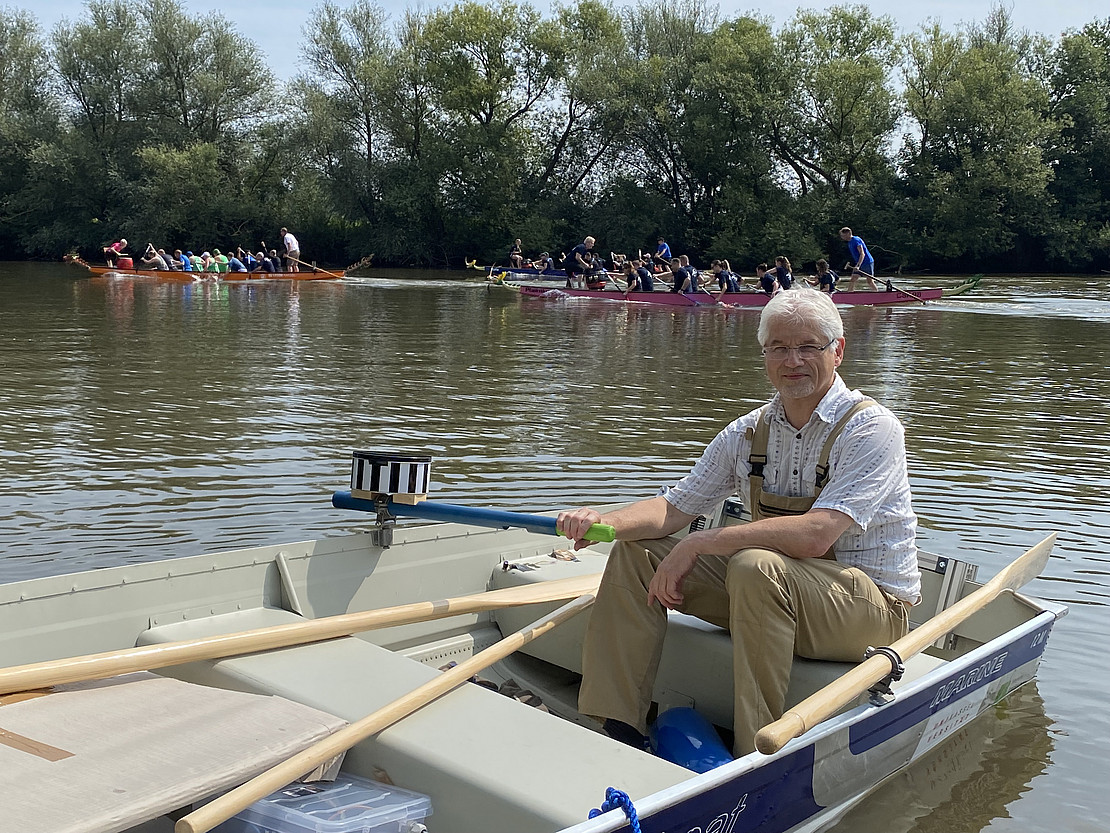This page contains automatically translated content.
E-bike for the water
 Image: Hoffmann.
Image: Hoffmann.A rowing boat without oars, supposedly sailing the wrong way round - last August, the Fulda was the scene of a world premiere. We are not talking about the Zissel, the Kassel river and folk festival that has been around for almost 100 years. What is meant is a strange vehicle that joined the dragon boat race this year
It was invented by Clemens Hoffmann, Professor of Integrated Energy Systems and occasional water sports enthusiast. A trip on the Lahn with his son ten years ago provided the inspiration: "We had to return the canoes and were running late. It was a struggle to make the last few kilometers. I thought: it has to be quicker and easier." His idea: to combine the power of a rowing boat with the maneuverability of a canoe.
The result is Hoffmann's now patented "e-Rowboat", a hybrid of canoe and rowing boat with a clever drive system. After many years of development, it made its first public outing at the Zissel dragon boat race at the beginning of August. The special features:
- The rower does not use oars, but levers, each of which is connected to a generator. Instead of a blade plunging into the water, electrical energy is generated using muscle power by moving the levers back and forth.
- This energy powers a jet drive, a water jet, similar to the nozzle of an airplane. The drive sucks in water from the river and shoots it out again at high pressure at the rear. The jet also acts as a rudder, as the direction of the jet can also be used to steer the boat.
- The seating position is now irrelevant for propulsion; if you are rowing, you can look ahead. What may initially seem irritating to onlookers makes rowing more enjoyable and safer.
- If necessary, a battery can be switched on to support the muscle power - just like the e-bikes that senior citizens use to easily outpace young athletes on the mountain.
One of the challenges is the development of an effective power generation system to convert the slow rotational movement and high torque of rowing into electrical power, reports Hoffmann. He is certain that the solution lies in an optimal combination of gearbox and generator.
At his department in Wilhelmshöher Allee, he and an international team of students have spent a lot of time working on a test bench set up especially for this purpose.
Hoffmann is still hoping for sponsors from the business world for further optimization. He is also looking for more students to take part in the project as part of their Bachelor's or Master's theses. The whole thing is more than just a gimmick. Hoffmann sees marketing opportunities in professional sport because the electronics produce a lot of data. "We can use the device to measure the muscular performance of a competitive rower very accurately, thereby improving their movement and determining their training status.
Hoffmann believes that the e-Rowboat has particular potential in the leisure sector: "E-bikes make cycling attractive for people who would otherwise find the sport too strenuous. It could be the same with rowing. In future, a boat trip from Kassel to Hannoversch Münden and back will become attractive for people who have never thought about it before."
TEXT Sebastian Mense